Anyone in the know about migraine knows about magnesium for migraine. But, when you see a neurologist or headache specialist, the doctors may not lead with specific information on the best magnesium for migraine. They may even forget to mention it as they focus on other priorities like medications, therapies and/or tests for you.
Your doctors may be like mine – they have info about it on a faded handout that they intend to give to you, but cannot locate the paper before you leave the office. So, you may head home without learning the importance of magnesium or which magnesium is best for migraines. You may leave the office with incomplete information about how to optimize this important supplement. They might have mentioned taking it, but did not suggest the best form of magnesium, range of magnesium dosage or potential side effects.
As a registered dietitian with migraine, this is one of my favorite topics because people are hungry for information about non-pharmaceutical relief. There are many forms available on the market and some conflicting information about which is the best form of magnesium as well as how much someone with migraine should take.
By the end of this article you will understand why magnesium is important to us, which magnesium is best magnesium for migraines and typical suggested doses. I’ll also spend some time helping those who have had some trouble taking magnesium figure out alternatives.
While Migraine Strong writes about the latest in migraine treatments, this is not medical advice. We are patient educators and all information you read should be discussed with your doctor.
Does magnesium help migraine attacks?
Many headache specialists know that magnesium is a brain-friendly substance. They know it can often play a role in preventing migraine as well as treating an attack.
While I was getting magnesium infused at Jefferson Headache Center a few years ago I asked how magnesium worked. The nurse practitioner said, “Magnesium for headache is just good. It’s a head-friendly substance.” Unsatisfied with that answer, I did a bit of research of my own.
Magnesium plays a number of roles in migraine and its pain process.
This important nutrient is literally involved in hundreds of chemical reactions in the body. Some of the biochemistry that may be related to helping prevent or treat migraine includes:
- Magnesium is needed to form neurotransmitters and to regulate various receptors, including those for serotonin, CGRP and others. Magnesium can block the action of glutamate, nitric oxide and other substances that can trigger a migraine attack. Glutamate is a substance that gets a lot of attention because of its important role in migraine as well as pain, traumatic brain injury and other brain disorders.
- Magnesium is thought to blunt pain signals by blocking transmission of pain in the nervous system.
- Magnesium relaxes muscles. Lessening muscle tension may be helpful in helping an attack go away faster and allow the person to feel soothed.
- Magnesium has a general calming effect on the nervous system.
Dr. Mauskop’s study of magnesium for migraine
During one of the annual Migraine World Summits, Dr. Alexander Mauskop, director of the New York Headache Center, discussed the importance of magnesium at length. Not only is Dr. Mauskop a key researcher of magnesium for headache, he is a prominent headache specialist who uses magnesium in several forms in his practice to help abort and prevent attacks.
Interestingly, in one study Dr. Mauskop discussed, people who did not get relief from a popular triptan (Imitrex/sumatriptan) had low magnesium levels. When their magnesium levels were increased, they found relief from this frequently prescribed and effective migraine medication.
In Mauskop’s own study on magnesium infusions, he showed very interesting and promising results. Of those people that came to his office and received infusions of magnesium for migraine attacks, the people who experienced relief tended to be those who were deficient as measured by the red blood cell (RBC) magnesium. Those that weren’t deficient didn’t get relief.
Studies with oral magnesium had good results, but the previous red blood cell levels of magnesium weren’t measured before or after the study. Based on the info from Dr. Mauskop, you have to wonder if those who had the best results with magnesium were those who were deficient and had the most to gain from replenishing their bodies with the magnesium supplement.
How do you know if you are deficient in magnesium?
Assessing your magnesium status is very tricky. Serum magnesium is not a good indicator as 98% of magnesium is stored inside cells or in bone. Serum magnesium test results can be normal even when someone is deficient in magnesium.
Magnesium is found in large amounts in muscle and bone. Our bodies regulate serum magnesium well by taking what is needed from the food we eat and getting rid of the extra amount through our kidneys. It is also regulated by the release of magnesium from muscle and bone to maintain the steady magnesium levels we need. While imperfect, the best practical measure of magnesium is the red blood cell magnesium test. Ask your doctor to test your RBC magnesium if you are curious.
Symptoms of low magnesium
Dr. Mauskop discussed the symptoms of low magnesium:
- Headaches
- Muscle cramps
- Cold hands and feet
- Premenstrual syndrome
- Mental fog
- Depression and irritability
- Palpitations
- Anxiety
Why do people with migraine need more magnesium?
There are quite a few reasons that people with migraine may need more magnesium:
- Stress alters magnesium metabolism. Potentially, we use more magnesium during stressful times and/or end up losing more in our urine when stressed.
- Genetics – there may be a gene effecting how much magnesium we absorb from our gastrointestinal (GI) tract and how much we end up flushing down the toilet.
- Typical intake among healthy Americans is usually less than the recommended daily allowance for magnesium.
- Those who struggle with frequent or chronic migraine often are less concerned with healthy food choices. This is not a judgement. This is the reality for many who do not have the energy or ability to plan, shop and prepare nutrient-dense foods on a regular basis.
- Many of us avoid certain foods high in magnesium because they may trigger migraine attacks (i.e. nuts, chocolate, legumes and avocado).
- GI disorders – many people with migraine have irritable bowel syndrome or bouts of diarrhea for other reasons. They may not absorb magnesium as well as other important nutrients. GI diseases like celiac disease and inflammatory bowel disease also raise the risk for having inadequate magnesium.
- Diabetes and many other chronic conditions are associated with low magnesium and affect so many of us. Diabetes is considered a near epidemic in the US with many people not knowing they have the disease or are on their way to having it (pre-diabetes).
Which type of magnesium is best for migraine?
There are many different types of magnesium. This section will cover the most important forms of magnesium for headache and migraine so you can learn about the best magnesium for migraine prevention.
A great option is to choose a blended magnesium supplement as the amount of magnesium recommended by neurologists is significant (discussed below). The blend that is a Migraine Strong favorite is BioEmblem Triple Complex Magnesium.
The benefit of this brand is that it contains 3 types of the better forms of magnesium. This blend allows more highly absorbable magnesium in each capsule so you need fewer capsules to meet your dose goal. Swallowing fewer capsules that also happen to be smaller is a big plus! You can find this product through this link or on the BioEmblem website.
Magnesium glycinate
If pressed to endorse just one form as the best magnesium for migraine, it would be magnesium glycinate (or magnesium bisglycinate). This chelated form is well absorbed by our GI tract. Chelated forms of magnesium (magnesium bound to an amino acid) are more bioavailable than other common forms. Practically speaking, this means that the magnesium glycinate take with your meals is actually being absorbed by your body rather than staying inside your GI tract and getting flushed down the toilet.
Since part of magnesium glycinate is the amino acid glycine, we may get some benefit there as well. Glycine may bring about a calming effect on our brain and help with sleep or in calming down dizziness in those with vestibular migraine. Most of us would benefit from help with sleep!
Magnesium glycinate can be a very helpful forms of magnesium for headaches. Some people with migraine are sensitive to gelatin, a common ingredient in many other magnesium supplements. Pure Encapsulations doesn’t use gelatin. For that reason, we like Pure Encapsulations Magnesium Glycinate .
Magnesium Threonate
This form is thought to improve cognitive function. Anecdotally, we have heard good feedback about increased energy and reduced brain fog with some people in our private Facebook group. We wish there were more studies on this form of magnesium for migraine and cognition. It is thought that this form of magnesium may be better able to cross that blood brain barrier and allow the magnesium to do its job where needed most. The downside of magnesium threonate is that it is pricey and less available at local stores. Many of us choose Pure Encapsulations for this form as well called CogniMag. Check out the Migraine Strong supplement dispensary for a discount on your supplement purchases.
In my opinion, magnesium threonate, like magnesium glycinate is a top contender for the best magnesium for migraine. However, I’m not sure it’s worth the additional cost.
Magnesium Citrate
Magnesium citrate is also very well absorbed so it can be helpful for those with migraine who also need some help with constipation. In large amounts, this form is sometimes used for bowel prep for colonoscopies. We do not recommend trying to get all of your supplemental magnesium this way especially if your bowels move along just fine.
The main idea behind supplementing is to have it absorbed, not flushed down the toilet. Fortunately, for many people, the laxative effect only occurs with higher amounts.
Magnesium citrate tends to be inexpensive. For many people, this form may be the best magnesium for migraine and headache.
For kids and those who have trouble with swallowing big capsules, Nature’s Vitality has magnesium citrate gummies that are pretty good. Garden of Life also makes a nice gummy. My 13 year old approves!
Magnesium Carbonate
When magnesium carbonate is digested by our stomach acid, it changes to a more bioavailable form. This Natural Vitality brand of magnesium, Natural Calm, is blended with citric acid. Anecdotally, this brand is helpful as it comes in different forms and flavors as well as an unflavored powder. As its name suggests, many find this form of magnesium for migraine calming. It’s also a good option for those who have difficulty swallowing capsules.
Magnesium Sulfate and Magnesium Hydroxide (milk of magnesia)
These forms are potent laxatives so beware if you try them. Since the role of these magnesium salts is to draw water into the GI tract and help move the bowels, the magnesium is not considered very bioavailable and is just flushed down the toilet. We do not recommend either type. Magnesium sulfate is also known as Epsom salt and can be used to boost your magnesium transdermally. Read on for more about magnesium baths.
Magnesium Oxide
This is the mostly common supplement on most shelves in pharmacies and grocery stores. It’s probably the most suggested by doctors as it’s familiar to them. We do not recommend this form of magnesium for headache and migraine due to its poor bioavailability, its laxative effect and GI distress.
Some sources say that only 4% of the magnesium in oxide capsules are absorbed, so the rest is flushed. This is certainly not the best magnesium for migraine.
What’s most disappointing is that because this form is common and inexpensive and our physicians often do not specify taking the more bioavailable forms, many think they cannot tolerate magnesium. It’s a missed opportunity. If you tried magnesium and found you couldn’t tolerate it, consider trying the what we think is the best magnesium for headache and migraine, magnesium glycinate.
What is the recommended dosage for magnesium?*
As per the John’s Hopkins migraine handout, it is recommended to take up to 400mg twice per day, so 400-800mg per day.
During the Migraine World Summit presentation, Dr. Mauskop suggested starting with 400 mg once per day. Once you know that amount is tolerated by your GI tract, double it. If that amount is tolerated, he suggests tripling it. That would mean 1,200 mg per day. That’s a LOT of supplementation with capsules and/or powders and gummies. However, some people may only see improvement with higher amounts.
Since achieving 800mg/day or more of magnesium means quite a few capsules to swallow as well as an adjustment to the family budget, many people find it effective, easier and more practical to take different forms. For instance, they may take 1-2 capsules/day of magnesium threonate, 2 -3 capsules/day of magnesium glycinate and they rest of the daily dose as a magnesium carbonate/citrate drink from Natural Calm or a magnesium foot soak.
How to read a magnesium label
Magnesium labels are not as straightforward as they would first appear. The amount of actual magnesium, or elemental magnesium, should be labeled very specifically. When you see the label indicating you are getting ‘Magnesium 400mg’ per tablet that seems like just what the doctor ordered. But, this labeling indicates that there is 400mg of the whole compound. Only a portion of that is actually magnesium. In this case, magnesium oxide (see label below) which is 60% elemental magnesium (the actual amount that matters). The 400mg magnesium oxide capsule therefore only contains 242mg of elemental magnesium.
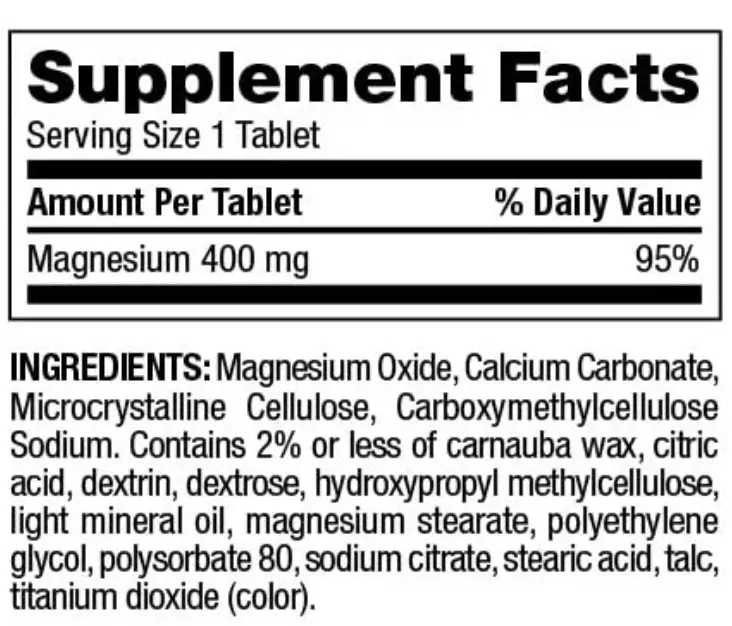
The more accurate labeling of magnesium (see below) will result in a label that says ‘Magnesium (as Magnesium Oxide)…500mg’. This indicates that the actual amount in the capsule should be 500mg of elemental magnesium. We know that reading labels is so important when following an elimination diet for migraine. It’s equally important for supplements.
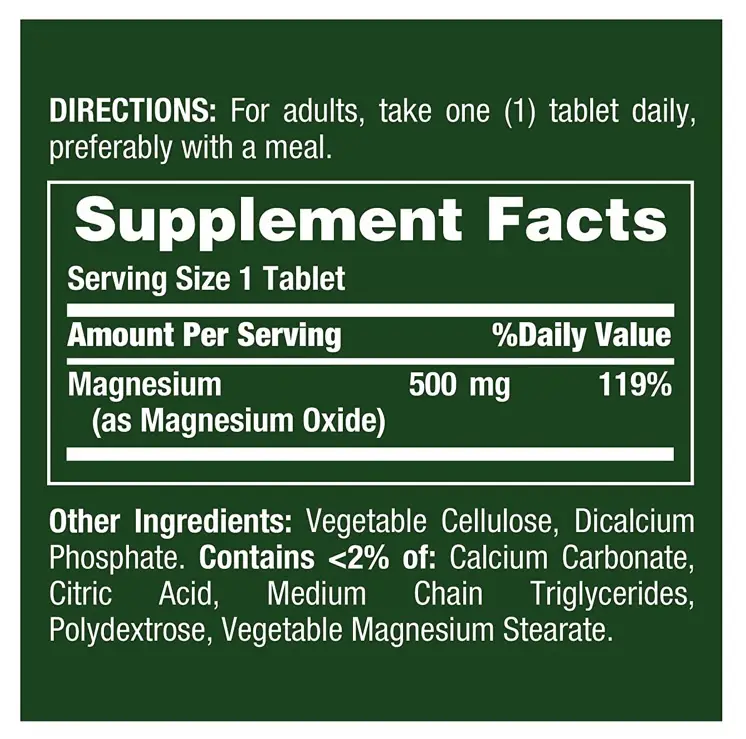
How long until you see results?
Some specialists consider magnesium supplementation both an acute treatment as well as a preventive. However, most would classify it as part of a good preventive regimen that needs some time.
According to a study that Dr. Mauskop published, magnesium levels decreased before or during an attack for many of the subjects. When he treated with intravenous magnesium the pain was relieved in 80% of the patients who were deficient within 15 minutes.
Evidence that oral magnesium helps during an acute attack exists but is thin. Anecdotally, some people find relief. In my opinion, it’s a reasonable and safe intervention when trying to save our precious few acute medications or trying to attack the migraine from several angles including your acute medication.
When making the commitment to try magnesium supplementation, some neurologists believe you need to supplement for 1- 2 months in order to see results. Perhaps this is how long it takes for some of us to replenish our magnesium stores and support important biochemical reactions in our nervous system.
Remember to track your progress- Adding magnesium for migraine control may help more than you realize. Of course, you’d notice if your attacks were reduced by 75% but would you notice if they were reduced by 25%? Whenever trying something new it’s important to track your results, so keep an eye on your migraine diary.
Is it safe to take magnesium supplements daily?
Many doctors say yes, but that doesn’t mean you should not do your own research as well as consult your own healthcare provider.
According to Dr. Mauskop, it’s one of the safest supplements to use for migraine, but urges caution when someone has kidney disease. In an article I consider a must-read about magnesium and migraine, Mauskop discusses risks in his final paragraph.
What if you cannot tolerate oral supplemental magnesium?
Unfortunately, some of us have very sensitive tummies. Even though the more absorbable and best magnesium for headache and migraine have been discussed above, some people may still have unacceptable symptoms. Here are a few suggestions:
- Always take magnesium with food.
- Since there are so many forms of magnesium, try each of the more absorbable types one by one. Yes, this can get frustrating and expensive, but is worth it if you find success. Give the ones that do not work well to someone you love. Magnesium is excellent for much more than migraine.
- Try two other forms that I did not mention above, magnesium chloride, magnesium taurate and magnesium malate. They are also typically well-tolerated.
- Experiment with the time of day that you take the supplement.
- Don’t get discouraged if you can tolerate only lower amounts of magnesium but not 400 mg/day or more. Take what you can and focus on eating some wholesome food sources of magnesium.
Topical or Transdermal Magnesium and Magnesium Baths
In addition to taking magnesium orally, you can try boosting the level of magnesium in your body via absorption through your skin. This is especially useful if you are unable to tolerate oral supplements.
To penetrate the many layers of our skin and get into our circulation, substances have to be able to penetrate the skin or get in via sweat glands and hair follicles. So, using topical magnesium in the form of gels, creams and oils may be helpful.
Bathing in magnesium sulfate (Epsom salts) and/or magnesium chloride salts may have even more benefit as the pores open and soften. Perhaps exposure of more concentrated amounts of magnesium to sweat glands and hair follicles helps to find its way inside.
Some people report consistent relief from warm foot soaks with magnesium chloride flakes. Jennifer Bragdon discusses how she relieves her dizzy symptoms from vestibular migraine in her recent article about natural remedies and magnesium for vertigo. Throwing a handful into a warming foot spa as you relax is a fun way to increase your daily magnesium intake. Topical lotions, sprays and roller balls are a nice option when you’re on the go. Whether it’s raised magnesium levels or the warm comforting self-care that salt baths represent, relief may be yours.
Magnesium Infusions
Intravenous (IV) magnesium infusions are another option to possibly help abort an acute attack. As mentioned above, Dr. Mauskop uses IV treatment in his office. He uses the treatment to help treat attacks as well as monthly infusions to steadily boost magnesium levels. Other doctor’s offices and headache centers also offer this treatment.
In some parts of the US, there are more infusion centers opening up that provide hydration, micronutrient drips as well as other treatments for acute and chronic conditions. This may be an option for you but ask your doctor for a referral if he/she does not provide the service. If they do not have one to recommend, be careful to only go to a facility that is run by a medical doctor.
Magnesium is one of the best “natural,” cheap, available, evidence-based and tolerated supplements there is for us. When asked about the things to do to help get control of migraine, considering magnesium is always at the top of the list. Understanding which magnesium is best for migraines may help you find the relief you are looking for.
** Alexander Mauskop, MD, is the Director and founder of the New York Headache Center in New York City. He is Board-certified in Neurology with a subspecialty certification in Headache Medicine. Dr. Mauskop is a Fellow of the American Academy of Neurology and the American Headache Society. He is a Professor of Clinical Neurology at SUNY, Downstate Medical Center. Dr. Mauskop has conducted breakthrough research in the field of headaches and published numerous articles in scientific journals. He serves as a reviewer for The New England Journal of Medicine, Neurology, Headache and other journals. His research on magnesium has been referenced several times in this article. You can read about his work in his blog – nyheadache.com/blog and buy his book The End of Migraines: 150 Ways to Stop Your Pain.
This article has been updated and refreshed since its original publication.
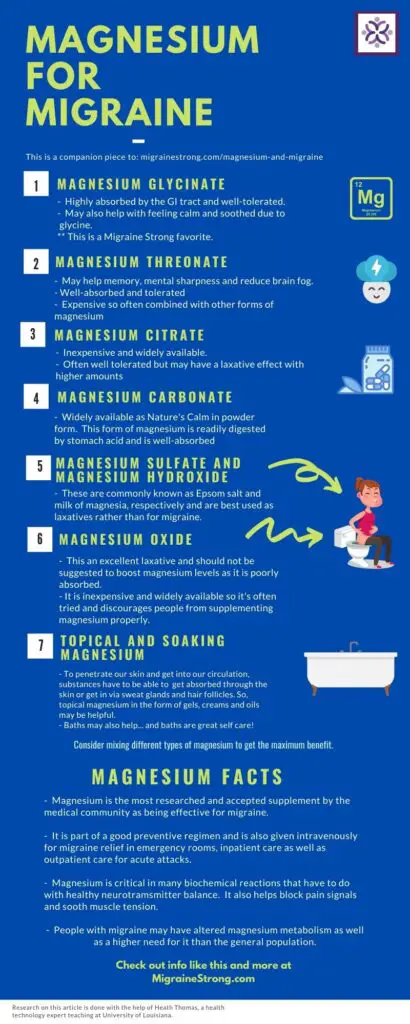

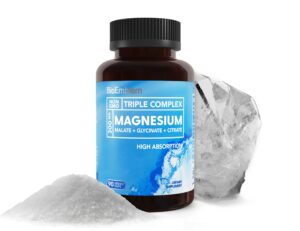
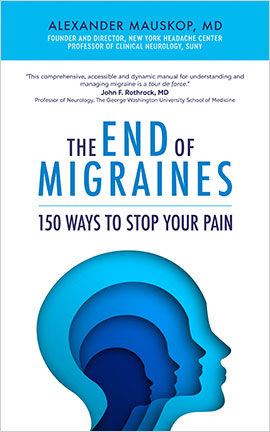
Great article! I usually recommend the glycinate form. Appreciate this resource!!
Glad you enjoyed the article, Marci. 🙂
Esta muy interesante el tema y que yo sufro de migraña
Great article! I am also a registered dietitian living with migraine (vestibular) and it’s a breath of fresh air to read something that hits close to home from someone with a similar background!
Hi Caroline. Thank you so much for your note and kind words. I hope you get better fast and spread the word about how other may help themselves. If you haven’t already, you may want to read all of jenn Bragdon’s blogs on this site for more help with VM. Thank you again! – Danielle
Great informative article, thank you.
I’m glad you enjoyed it enough to comment. That means a lot to me. Thank you! – Danielle
What about magnesium taurate? That’s a type I saw recommended elsewhere and have been taking but you didn’t mention it here.
Hi Natalie. Thanks for reading and posing a question. There are many forms of magnesium and I didn’t cover all of them. Magnesium taurate is another good one to try it’s just less available on most shelves. That factored into my decision to not include it in the article. It’s thought to be an especially good mag supplement for those looking lower their blood pressure. There is some research about it benefitting our cardiovascular system. I hope you are able to get your migraine attacks under great control soon. – Danielle
Thanks so much this is so clear and helpful. My doctor seemed a little dismissive when I mentioned I’m trying magnesium for my migraines. I feel confident in doing so though because of your article. It’s certainly helping me with a few other issues too.
Hi, Thanks for the info. What are your thoughts on Magnesium Malate?
Hi. Lizzie- I like magnesium malate as it’s chelated and usually well-tolerated. I decided to not discuss it as it’s not as easy to find and I had to draw the line somewhere 🙂 Thank you for writing! – Danielle
Danielle I’d like to work with you. How do I reach you. Or can you reach back out to me
Email Danielle at [email protected]. Thanks!!
Justine, I have had a few doctors – some were neurologists but not headache specialists – who were also dismissive. I think it makes sense to do our own research too and to trust our instincts, even with very good doctors. I’m glad magnesium is helping you with other issues too!
Danielle, thank you for your article. What type of elimination diet did you do? I’m newly diagnosed with vestibular migraine and want to do everything I can to remove these horrible symptoms.
Hi Kati- Thank you for writing to us but I’m sorry you are dealing with this. Social media has changed the way we learn about managing many conditions. Education and empowerment are key. I highly recommend reading EVERYTHING on this site written by Jennifer Bragdon as she has VM and helping people like you is a passion of hers. I’ll link just one of many of her articles. The elimination diet I followed was very similar to the HYH diet she discusses. I was just a little more strict in that I also skipped all legumes and eggs but that probably wasn’t necessary. Good luck to you: https://www.migrainestrong.com/drowning-in-symptoms-how-i-overcame-chronic-vestibular-migraine/
Hi Danielle, I really appreciate this article as I have been using magnesium as part of my “migraine cocktail.” And this article provided me with the best type of Magnesium to use. Although I do have one thing I’d like to mention that you didn’t hit on. Is that you should always consult your doctor before taking Magnesium, while magnesium is great for the body in so many ways besides migraines. If you do have certain chronic illnesses etc. magnesium can be harmful to your body, especially with people who have certain heart problems as to much magnesium can be bad for your heart. I know it seems like common sense to consult your doctor about adding something to help prevent your migraines that is OTC, but not all people see it that way. Thank you so much with this article, through reading this I found I have been taking the wrong magnesium which was Magnesium Oxide lol no wonder I was going to the bathroom a lot. Lol
Why is Magnesium Citrate suggested when according to the HYH diet citric acid is clearly should be avoided?
Hi Jillian. Thank you for writing. Citric acid is one of those additives that some people have trouble with in larger quantities but is often fine in smaller amounts. On page 86 of the HYH book, Dr. B states that it is permissible. From personal and professional experience, I think people should be cautious of citric acid in large quantities but not small amounts (like in jams/jellies and sweet treats). I avoided it until I was well controlled as I noticed that during the years that I had frequent attacks after taking mag citrate I felt awful. I’m happy that it doesn’t trigger me now that my attacks are less frequent. The magnesium supplements we recommend most are mag glycinate and mag threonate. These are harder to find and expensive. For those who wish to add a less expensive magnesium type to their routine, I think it’s reasonable give mag citrate a try as it’s easy to find and inexpensive. -Danielle
Thanks for the very informative article.
One pain management doctor recommended magnesium and vitamin B2.
I have a different pm md now and I mentioned to him that I switched magnesium citrate to glycinate and added CoQ10 and migraine intensity has decreased; he only acknowledged the CoQ10
Anyone know another good glycinate brand with a smaller pill I have a hard time with big pills and the pure encapsulation makes me gag
There are some bulk magnesium glycinate products you can buy. These can be added to a smoothie or applesauce to make it easier to take. If you already have the Pure Encapsulations brand, check with your pharmacist to see if you can open the capsules and add to a smoothie so that you don’t have to waste them.
Is it best to take it at night?
I was only taking 240 a day and every few days was ending up with diarrhea. I was taking the pure encapsulations glycinate 🙁 so bummed because I really need the magnesium but I don’t think my GI will tolerate.
Also I was wondering, I was taking magnesium to prevent migraines but specifically the aura. Is there anything else I can take supplement wise that could help, if I can’t tolerate oral magnesium?
Sorry magnesium has been a challenge for you. You could try other forms as well as getting infusions to see if that helps. As far as other nutrients, we have articles that include info on riboflavin, feverfew, melatonin, turmeric, ginger and other non-pharma helps. Tomorrow we are publishing a new article about coQ10. It’s important to always have hope and something else to try. I’m sure there is something out there that can help you. I hope you find the right combination of things to bring relief 🙂 https://www.migrainestrong.com/5-proven-nutrients-that-help-with-migraine/